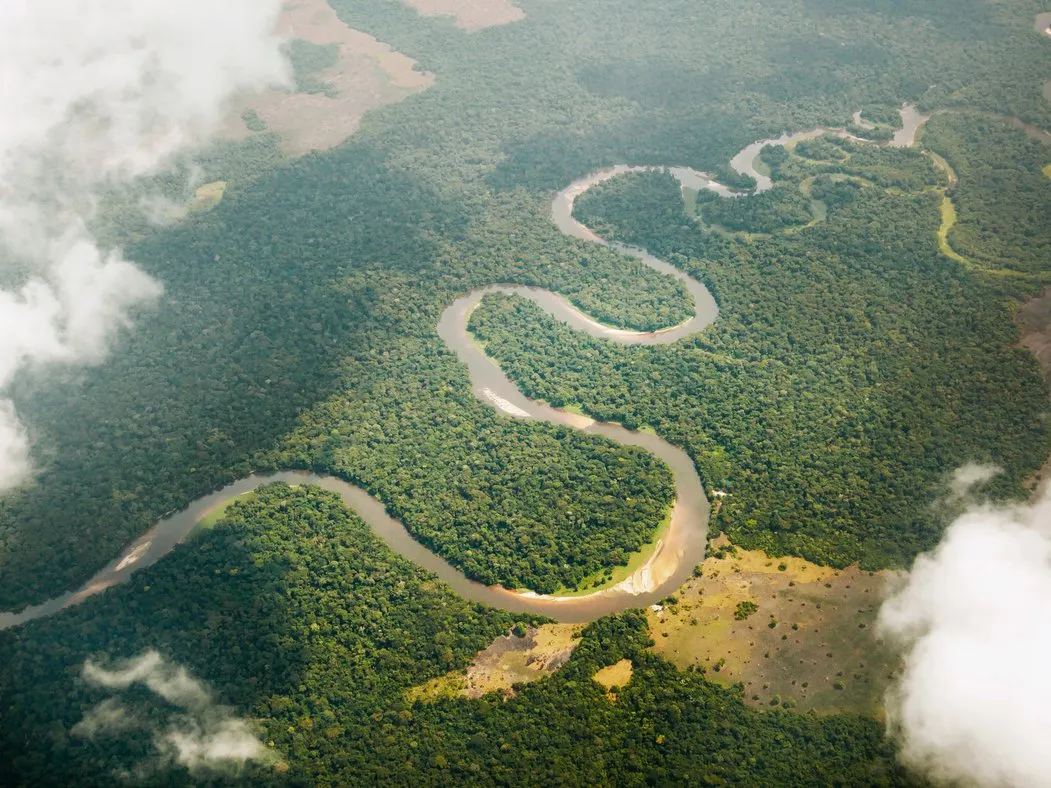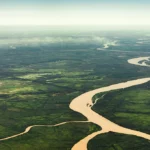Rivers, like giant ribbons of water, flow through our planet, shaping the land and supporting all kinds of life. But have you ever wondered which river reigns supreme in terms of sheer width? This journey takes us to the heart of this intriguing question, exploring the contenders and the complexities of measuring these natural wonders.
What is the Widest River in the World?
The quest to crown the world’s widest river often leads us to two impressive contenders: the Amazon River and the Río de la Plata estuary. Both waterways boast extraordinary dimensions, sparking debate and highlighting the nuanced nature of geographical classifications.
The Amazon, a titan among rivers, flows through the heart of South America, its reach extending for thousands of miles. During the dry season, it stretches an impressive 7 miles (11.3 kilometers) wide at its mouth. However, when the rains come, this watery giant swells to a staggering 15 miles (24 kilometers) wide, showcasing the dramatic impact of seasonal changes.
Meanwhile, nestled between Uruguay and Argentina, the Río de la Plata estuary presents a compelling case for the title. This vast expanse of water, where the Uruguay River merges with the Paraná River before meeting the Atlantic Ocean, also measures a formidable 15 miles (24 kilometers) wide.
So, why the debate? The crux of the matter lies in defining the “width” of a river. Should measurements be taken at the river’s mouth, where it kisses the sea, or further upstream? How do we account for the ebb and flow of water levels influenced by seasonal variations? These are questions that continue to occupy the minds of geographers and scientists, reminding us that the natural world rarely conforms to rigid definitions.
While the Amazon’s extraordinary size is undeniable, the Río de la Plata estuary adds a layer of complexity to the equation. This ongoing discussion exemplifies the dynamic nature of our planet, where scientific understanding is constantly evolving.
Is the Amazon River the Widest in the World?
The Amazon River, a colossal force of nature, often claims the title of “World’s Widest River,” and for good reason. Its sheer scale is difficult to comprehend, even with the aid of maps and satellite imagery. But is this title truly undisputed?
The answer, as with many natural phenomena, is nuanced. The Amazon’s width isn’t static; it ebbs and flows with the rhythm of the seasons, much like a giant water balloon inflating and deflating. During the rainy season, the Amazon swells to an astounding 25 miles wide, dwarfing many other significant rivers. To visualize this, imagine 25 Brooklyn Bridges spanning its surface!
Even during the dry season, the Amazon remains an impressive 6.8 miles wide—still substantially wider than many major cities. This dramatic fluctuation in width, driven by seasonal changes in rainfall and water flow, highlights the dynamic nature of river systems.
Why So Wide? It’s All About That Flow!
The secret to the Amazon’s impressive girth lies in its unparalleled volume of water. This mighty river carries more water than the next seven largest rivers combined, a testament to its status as a hydrological giant. This immense volume of water, originating from a vast network of tributaries and fueled by abundant rainfall, is the primary reason for the Amazon’s incredible width.
But the story doesn’t end there. The Amazon’s width is more than just a geographical statistic; it’s a defining characteristic that profoundly shapes its ecosystem, influences regional and global climate patterns, and impacts the lives of millions of people who depend on its resources.
The Amazon’s Width: A Big Deal for Nature and People
Imagine a river so wide it dictates the rhythm of life for countless species, creating a tapestry of diverse habitats along its banks. This is the Amazon. Its vast expanse gives rise to a mosaic of environments, from serene backwaters and flooded forests to turbulent rapids, each teeming with unique flora and fauna.
The Amazon’s width also plays a vital role in supporting the livelihoods of people living in the Amazon Basin. It serves as a critical transportation route, connecting communities and facilitating trade. The river’s floodplains, enriched by nutrient-rich sediment deposits, provide fertile ground for agriculture, sustaining local communities for generations.
Exploring the Mysteries of the Amazon: More to Discover!
Despite decades of scientific exploration, the Amazon remains a place of wonder and mystery. Scientists continue to make groundbreaking discoveries in its depths, uncovering new species and unraveling the intricate web of life that thrives within this unique ecosystem. As we delve deeper into the Amazon’s secrets, we gain a greater appreciation for the interconnectedness of our planet’s systems and the importance of protecting this invaluable natural treasure for future generations.
What is the widest river in Asia?
Shifting our focus to Asia, we encounter another contender for the title of “Widest River”: the mighty Brahmaputra. This transboundary river, originating in the Himalayas and flowing through China, India, and Bangladesh, exhibits remarkable variations in width along its course.
At its widest points, the Brahmaputra stretches an impressive 36 to 37 kilometers—that’s roughly equivalent to driving for an hour with water on both sides! This remarkable breadth dwarfs even other well-known Asian rivers like the Yangtze, Mekong, and Indus, solidifying the Brahmaputra’s position as the widest river in the continent.
The Brahmaputra’s impressive width isn’t just a geographical quirk; it’s a defining feature that shapes its ecological and economic significance. The river’s wide channel and expansive floodplain create a diverse array of habitats, from shallow wetlands and sandbars to deep, fast-flowing channels. This mosaic of environments supports a rich tapestry of life, making the Brahmaputra a biodiversity hotspot.
For the millions of people living in the Brahmaputra Basin, the river is a lifeline. Its waters irrigate vast agricultural lands, providing sustenance and livelihoods. The river also serves as a crucial transportation artery, connecting communities and facilitating trade.
What is the 1 largest river in the world?
The title of “largest river in the world” can be interpreted in various ways, depending on what metric we use to define “largest.” If we focus on width, as we have in this exploration, the Amazon River reigns supreme. Its impressive 7-mile width at its widest point earns it the official recognition of the Guinness Book of World Records.
However, when considering other factors like length and discharge (the volume of water flowing through a river), the picture becomes a bit more complex. The Nile River in Africa often claims the title of “longest river in the world,” stretching over 6,650 kilometers (4,132 miles) from its source to its mouth. And while the Amazon is the undisputed champion in terms of width, it’s also the world’s largest river by discharge, pouring a staggering 20% of the world’s total freshwater into the ocean.
This interconnectedness of factors—width, length, discharge, and the intricate interplay of these elements—highlights the complexity of river systems and the challenges of definitively ranking them. Each river, with its unique characteristics, plays a vital role in shaping the landscape, influencing climate patterns, and supporting a web of life that extends far beyond its banks.
Exploring Further:
Eager to learn more about the world’s most impressive waterways? Discover the titleholder of the longest river in the world. The largest river in Asia offers a majestic journey. Explore where rivers meet the ocean at the mouth of the river. Curious about the world’s widest river? Find out. Discover the longest rivers in Africa and their remarkable lengths. Finally, don’t miss out on the two largest rivers in the US, symbols of the nation’s grandeur.












